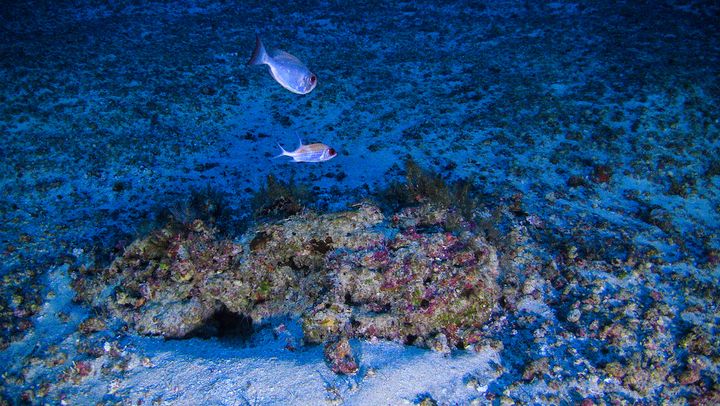Have you heard about the coral reef that was just discovered in the Amazon? If you did, you’re not alone—millions of others have too, as it was one of the most-read science stories of 2016. Unfortunately, when the story broke, I was diving in the Philippines and did not have time to clarify the headlines (mainly that this is not a new discovery), but the reef is back in the news because it is being filmed for the first time. Now that I’m back at my desk and exciting new footage is bringing much-deserved attention to this reef system, it’s time to set the record straight.

Image of the Amazon Reef taken from a submarine launched from the MY Esperanza. The Greenpeace ship is currently in the region of the Amazon river mouth, Amapá State, for the “Defend the Amazon Reef” campaign.
This is a story about a reef that was discovered in 1977, in 2015, and then again in 2016. It all began in May 1975 when a scientist from the National Museum of Natural History at the Smithsonian Institution, fish expert Bruce B. Collette, went on a research cruise to a previously unsampled area off the mouth of the Amazon River. He—the true discoverer—sampled 57 sites along a ~700 kilometer line parallel to the Amazon mouth and found fishes typical of coral reefs in 14 of those sites. He also found several species of reef sponges and after sending them to the Smithsonian’s sponge expert, Klaus Rützler, they concluded that there was a complex reef in the area supporting diverse groups of reef-associated animals of Caribbean origin. The reef is described as so rocky at its southern portion that it couldn’t be sampled with their shrimp trawl (the southern portion is also identified by modern papers as the most complex area). Back then, this remarkable discovery received no public attention.
Collette and Rützler’s work was used by dozens of research labs (including my own) during the decades that followed to demonstrate and explain how reef-associated organisms in the Atlantic use this reef off the Amazon mouth as a corridor to connect areas in Brazil to the Caribbean, just as they predicted. Since one recent headline says that “we found a reef where the textbooks said there shouldn't be one”, it should be noted that the Amazon reef, as well as an account of how it works as a corridor, appeared on page 278 of the 1997 edition of the textbook The Diversity of Fishes, and again even more detail on its function as a corridor for genes between Brazilian and Caribbean fish populations is given on page 334 of the 2010 edition of the same book.
Fast-forward to 2015 when a group of scientists from Brazil publishes a paper titled “Mesophotic coral ecosystems occur offshore and north of the Amazon River”. Using museum specimens collected during several different expeditions to the Amazon mouth (including the one conducted in 1975), they list 38 corals from 79 sites in the area. That paper received no media attention, probably because the authors didn’t claim that the reef was a new discovery, but rather, emphasized that the reef was also home to several coral species in addition to the sponges and fishes previously recorded.
And that brings us to 2016. The paper “An extensive reef system at the Amazon River mouth” was published in April and the news that a new reef was “discovered” in the Amazon spread like wildfire. With a few exceptions, the species recorded in the 26 sites sampled for this 2016 paper had already been recorded in the 57 sites sampled for the 1977 paper and the 79 sites for the 2015 paper. Therefore, the novelties of this paper were that 1) they conducted the first detailed sonar survey of the area; 2) they used water samples to conduct a metagenomic analysis in the area; and 3) they collected and dated carbonate rocks from the reef. Don’t take me wrong, it’s an excellent paper and the most detailed description of the reef to date, but it just isn’t the paper where the discovery was made. That was back in 1977.
Every scientist that has worked on Brazilian reefs over the past 20 years (and many well-informed scientists in other areas) knew that those reefs were there. The authors of the 2016 paper do cite both the 1977 and the 2015 papers, but they greatly downplay their results (even though both older papers sampled more sites than they did). The 2016 paper also states that previous authors failed to report several key features of the reef, which they might have due to different sampling strategies, but that doesn’t mean that the scientific community didn’t know the reef was there.
I am not sure why this 2016 publication was portrayed as a new discovery, but scientific research (and the hardworking people who pioneer new fields and discoveries) deserve great respect. Consider: The deepest trench in the ocean (close to 11,000 meters beneath the surface) is in an area known as the Challenger Deep. The area is named after the HMS Challenger because the first depth recordings there were made aboard a 19th century pioneering expedition in that ship. Those recordings were made in a very low-tech way—scientists basically dropped a weight attached to a line to the bottom, and then measured the line, which resulted in measures that are not precise. But they did find the deepest trench in the ocean. In 2009, the RV Kilo Moana made the most detailed multibeam sonar readings of the trench to date and produced a beautiful 3D map of the area with very accurate depth measurements. We wouldn’t say that the deepest trench in the ocean was discovered in 2009 by scientists aboard the Kilo Moana, just as we shouldn’t say that this Amazon reef was discovered in 2016.
Here are the facts:
- Many headlines report that this is a coral reef, but it is not—this reef is mostly built by non-coral organisms and only a few reef-building corals have ever been recorded in the area.
- This reef is not restricted to the Amazon mouth. It probably extends from the southern Caribbean all the way to southeastern Brazil along the edge of the continental shelf at depths between 40 and 100m (my colleagues and I describe very similar reefs in northeastern Brazil in a paper published in 2000).
- Even if the area just off the Amazon was treated as a separate reef, it was discovered in 1977, not 2016.
- Scientists aboard Greenpeace’s Esperanza ship are taking a look at it now for the first time, and the images so far bear a striking resemblance to reefs that I have seen at similar depths elsewhere along Brazil’s tropical coast.
The recent rash of sensational reporting has had one positive effect: because of the sheer force of media attention surrounding the “new discovery”, the Amazon reef, which is threatened by overfishing and oil and gas exploration, might finally get the protection it deserves. However, now (more than ever), we have to be critical of misleading science headlines and the bulldozing of foundational research that helps us understand and protect the planet. Whether you’re a scientist, a journalist, or just simply curious about fascinating global discoveries, it’s time to demand a truthful look at the stories that capture the headlines.
